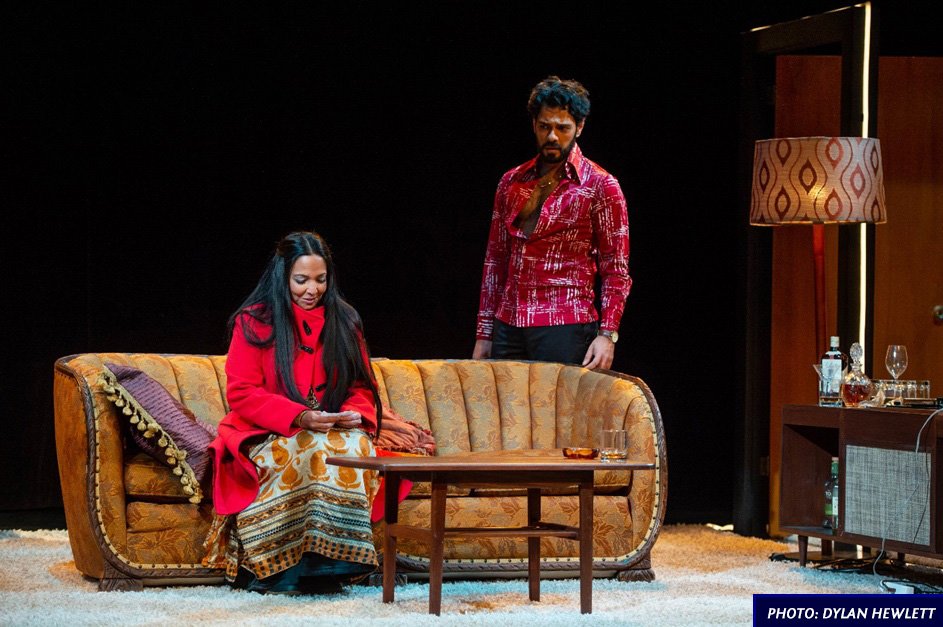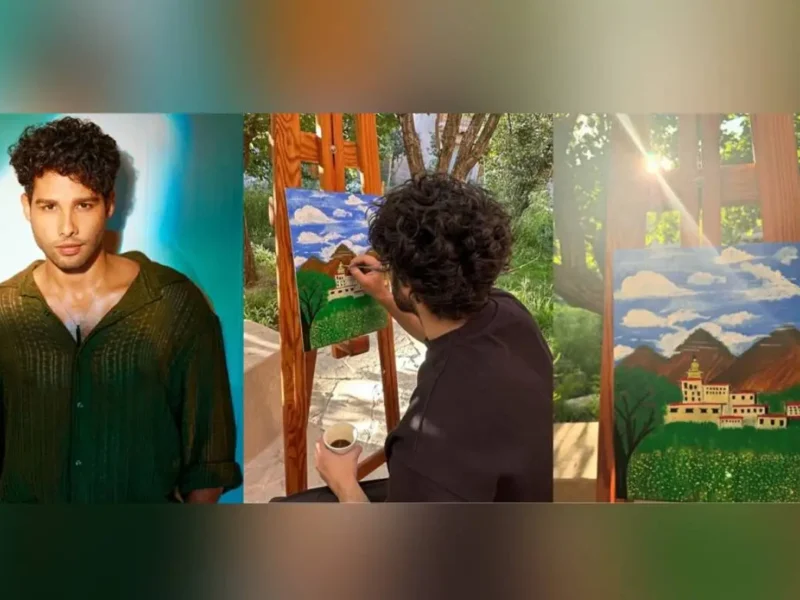
Canadian Playwright Explores Identity, Sexuality, And The Meaning Of Freedom
Photo : Pamela Mala Sinha writes and acts in her third play, ‘New’
Pamela Mala Sinha is a Canadian actress and playwright. On television, she has had recurring roles as Wanda in ‘Street Legal,’ Rani in ‘The Newsroom,’ Faith Colero in ‘Traders,’ and desk clerk Amira in ‘ER.’ Her latest work is ‘NEW’ revolving around the arrival of a Bengali bride to a small university town that shakes up a tight-knit group of Indian immigrants, including the husband she’s never met. Here, in her words, she tells India-West how it came to be.
By PAMELA MALA SINHA
Special to India-West
‘NEW’ is my third play, and is set in Winnipeg in 1970, inspired by my parent’s generation. My parents, Snehesh and Rubena Sinha, emigrated to Canada in the mid-late ‘60s. My mother was a dancer in Uday Shankar’s troupe, and my father was recruited from the London School of Economics by the Universities of Hawaii, McGill, and Manitoba: he chose Manitoba because he was excited about the snow! They built a ‘family’ from a small group of bachelors and married couples who were Hindu, Muslim, Sikh, Christian – it didn’t matter – they celebrated everything together.
To be honest, the desire to write this play came from a place of rage and sadness. When I hear of an Indian or Chinese-born older person being told to ‘go back to your own country!’, I want to scream back – this IS their country. They came of age here, gave all they had, and you and I, are beneficiaries of those gifts of knowledge and love.
But how would people know when there’s a gap in the cultural narrative? How are they to know that the elder they yelled at helped change a small college into the respected university their children now attend? Or helped build the hospital where they were born? My Uncle Biswas was one of those bachelors who became my parent’s ‘family’ here. He called my mother ‘Bodhi,’ sister-in-law, and my father, ‘Dada,’ big brother. When he died, it felt like I had lost Daddy all over again. As I looked through my aunt’s old albums of them in their early days in Winnipeg, I saw photos of vibrant, cigarette-holding, scotch-drinking couples in filmy chiffon saris and skinny ties that looked way cooler than the depictions of “brown” immigrants that inundate present popular culture.
At the time I had just completed a run of performing CRASH, a solo play I wrote and dealt with grief and loss, in New York with Soulpepper Theatre Toronto, so when they offered me a commission for a new play, I knew it was this I wanted to write about.
So, armed with my mother’s stories as an ‘entry point’, I interviewed those aunties and uncles about marriage and loneliness, and home. I knew because they saw me grow up, they would be more willing to open up to me. At first, they were shy to be asked. Though the specifics were different, they were a generation like our own; negotiating sex and love and personal identities the best they could, while helping to shape the political and social ideals of their adoptive country thousands of miles from the country in which they were born.
In NEW, I have tried to capture some of the things they told me mattered to them; the complex nature of love and sacrifice, joyful togetherness and piercing loneliness, their unique conflicts, and what it means to be thought of as ‘new’ because of how you look; in a country where you are not ‘new’ because the country is your home. This play is a tribute to them; an attempt to fill (in some small way) that narrative gap, and most importantly, as a reflection of where we came from through a lens that is our own.
In writing and now rehearsing NEW I have slowly felt that initial rage transform to love. For the courage of those young professionals and their often even younger wives who tried, failed, tried again, and finally flourished in Canada at a very specific time in the shaping of this nation. If NEW is anything it is a love poem to them… and to our own children.
Because this play was inspired by the existence of those who came before me, then crafted by my imagination and theatrical expression, I think it’s important to end with my mother’s own words. I felt so proud she was willing to share them with me, and now I am equally proud to share them with you…
I was seven years old when Kelu Nayar, a famous dancer, came to our town. I wanted to take his class, but my family was against it; dancing was for prostitutes. But my mother believed in Gandhi’s philosophy: everyone has a right to be what they wanted. She was a brave woman. And I became a dancer. I danced all over India, working with the great Uday Shankar who was creating different interpretations of classical dance with his brother Ravi Shankar’s music.
After three years of touring, I had to join my husband in Winnipeg. It was February. I was so shocked by the snow I couldn’t move for a month. One day there was a storm – so heavy I sat at the window and thought my husband will surely drown in the snow. I wanted to go back home but I knew I would have to embrace this country as my own. We didn’t know each other very well, and we worked hard on our relationship. Language was a barrier for me, and it took a long time to learn English.
But then, I discovered ballet – dance could go beyond any language. So I walked into the Winnipeg ballet school, pointed at myself, and said “I – dance.” And they understood me! They asked me to dance for them and I did. But I was too old for ‘real’ ballet. And I was an Indian dancer, so my tradition moves towards the earth as opposed to ballet, which goes “up and away”! But because I knew my art so well, I started to communicate with the other dancers and slowly, with dance as our common ground, I found my community. A group from the University of Winnipeg called ‘Cubiculo Theatre’ found me. It was very exciting because they were not just dancers, they were theatre people! I met my best friend there. I learned about theatre as well as a ‘Western’ way of looking at things. And they embraced me as an Indian dancer. I performed my first show in Canada with them: Mahadevi Akka. I danced the part of Mahadevi, and the actors recited her poetry.
In my life as an artist, I’ve met some wonderful people. But two who stand out are Daphne Korol and her husband, the designer Ted Korol. Daphne’s ‘Children’s Dance Theatre’ became a part of me. She gave me the freedom to use my imagination with children: to experiment with movement and create dance dramas. I also became involved with the Indian community’s newly formed School of Dance around which time I met Eugene Kostyra, then the Minister of Culture. When he invited me to take over as chairperson of the Centennial Corporation, I resisted at first (I was an artist) but I realised this was an opportunity to help make meaningful change that would benefit our whole artistic community. I was there for five years. It was then I decided to create my own company – ‘Fusion Dance Theatre’. One of my thoughts behind creating the company was “what does Canada look like?” Canada is multicultural – we had (and have) access to so many cultures in the city. We all talk to each other – about our way of life and our ways of making art. But Canada has her own story and I wanted to know it. When the Artist in the Schools program sent me to northern reserve schools, my eyes opened to the injustices suffered by the First Nations people. An elder asked me some very hard questions during one visit. He must have been pleased with my answers because he invited me to come back and learn from him. Dave Courchene had a deep impact on my life. From that point, the relationships I developed with Manitoban Indigenous elders and artists became a strong thread in my work and my understanding of what it means to be “Canadian”. With their support and collaboration, I mounted my next show Quest: a dance drama performed by Indigenous dancers and musicians with Indian Classical dancers and musicians. Rehearsals for Quest were almost more important than what happened on stage; learning each other’s points of view and unique artistic process was intense and hard and beautiful. With that hard-won understanding we created a single story that had space for everyone. A commission from the Winnipeg Art Gallery followed. I choreographed a multi-media dance drama based on the painting ‘The Rape of Lucrece’. The final show I created with Fusion was Patterns in Snow. It was about how snow impacted us all on our arrival to Canada, and the story of how each of us found a sense of home in our new country. This country gave me the chance to express myself as an artist. It has embraced what I have to offer – first as a dancer – and now in my life, as a storyteller. I have had a very deep and fulfilling life here. It is so lovely to come back to the theatre with my daughter here – at home.
(NEW by Pamela Mala Sinha, a Necessary Angel Theatre Company production, runs in Toronto from April 25 to May 14 at Berkeley Street Theatre, Canadian Stage. Learn more here.)




